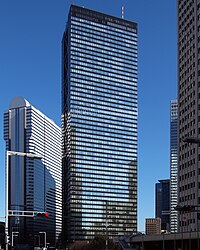Shinjuku Mitsui Building
| Shinjuku Mitsui Building | |
|---|---|

Shinjuku Mitsui Building at sunset
|
|
| General information | |
| Type | Office |
| Location | Shinjuku, Tokyo, Japan |
| Coordinates | 35°41′31″N 139°41′38″E / 35.691898°N 139.693903°ECoordinates: 35°41′31″N 139°41′38″E / 35.691898°N 139.693903°E |
| Construction started | 1972 |
| Completed | 1974 |
| Opening | September 1974 |
| Owner | Mitsui Fudosan |
| Height | |
| Architectural | 224.9 m (738 ft) |
| Roof | 212.1 m (696 ft) |
| Technical details | |
| Floor count | 55 |
| Floor area | 176,671 m2 (1,901,670 sq ft) |
| Design and construction | |
| Architect | Nihon Sekkei |
| Developer | Mitsui Fudosan |
| Structural engineer | Kiyoshi Mutō |
The Shinjuku Mitsui Building (新宿三井ビル? Shinjuku Mitsui Biru) is a high-rise building in Nishi-Shinjuku, Shinjuku, Tokyo. It is owned by Mitsui Fudosan. It is the one the 10 tallest buildings in Tokyo, and was the tallest building in Tokyo and Japan from September 1974 until March 1978, when Sunshine 60 was completed.
It was built in the style of high-rise buildings that were being built in the United States in the 1970s. It is notable for the black diagonal braces on its east and west facades. At the base of the skyscraper is a sunken garden and a surprisingly large plaza. In addition to the sunken garden, there is also a roof-top garden.
With its black facades, Shinjuku Mitsui Building stands out among the skyscrapers in Shinjuku. It is located next to the Shinjuku Center Building, which is two meters lower but appears to be taller because its first floor is located on higher ground. It made an appearance in the 1984 film The Return of Godzilla.
The building's height is 212 meters to the top of the roof, and 225 meters to the architectural top. Its entrance lobby is on the second floor. The X-shaped steel braces on the side of the building serve as seismic reinforcement and also as braces for the doors of the machine rooms at each end of every floor. The doors are 4–5 floors tall, for replacement of equipment such as air-conditioners. As in the older Keio Plaza Hotel, some fire escape exits are exposed outside the building to prevent smoke from accumulating in the case of fire.
In 2013, Mitsui Fudosan and Kajima Corporation began installing six massive pendulums on the roof of the building to counter long-period earthquake ground motion. The pendulums will reduce magnitude of building motion by half or more during a major earthquake, such as the Great East Japan earthquake of 2011.
...
Wikipedia
